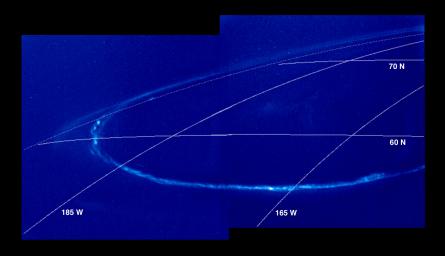Jovian aurora on the night side of the planet. The upper bright arc is auroral emission seen "edge on" above the planetary limb with the darkness of space as a background. The lower bright arc is seen against the dark clouds of Jupiter. The aurora is easier to see on the night side of Jupiter because it is fainter than the clouds when they are illuminated by sunlight. Jupiter's north pole is out of view to the upper right. The images were taken in the clear filter (visible light) and are displayed in shades of blue.
As on Earth, the auroral emission is caused by electrically charged particles striking the upper atmosphere from above. The particles travel along the magnetic field lines of the planet, but their origin is not fully understood. The field lines where the aurora is most intense cross the Jovian equator at large distances (many Jovian radii) from the planet. The faint background throughout the image is scattered light in the camera. This stray light comes from the sunlit portion of Jupiter, which is out of the image to the right. In multispectral observations the aurora appears red, consistent with glow from atomic hydrogen in Jupiter's atmosphere. Galileo's unique perspective allows it to view the night side of the planet at short range, revealing details that cannot be seen from Earth. These detailed features are time dependent, and can be followed in sequences of Galileo images.
North is at the top of the picture. A grid of planetocentric latitude and west longitude is overlain on the images. The images were taken on November 5, 1997 at a range of 1.3 million kilometers by the Solid State Imaging (SSI) system on NASA's Galileo spacecraft.
The Jet Propulsion Laboratory, Pasadena, CA manages the Galileo mission for NASA's Office of Space Science, Washington, DC. JPL is an operating division of California Institute of Technology (Caltech).
This image and other images and data received from Galileo are posted on the World Wide Web, on the Galileo mission home page at URL http://www.jpl.nasa.gov/ galileo.

 Planetary Data System
Planetary Data System












